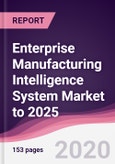Enterprise Manufacturing Intelligence can be defined as software that is used by many process and discrete industries for bringing an organization’s manufacturing related data together from multiple sources for the purpose of reporting, analyzing and passing data between enterprise level and plant floor systems. The primary goal of any enterprise manufacturing intelligence system is to extract real knowledge from large chunks of manufacturing data which in turn will give positive business results. Globally, increasing competition amongst organizations and increasing importance of data analytics is expected to remain the key growth driver for EMI during the period of study.
Geographically, North America dominated the enterprise manufacturing intelligence market driven by higher usage and penetration of enterprise manufacturing intelligence systems into various end-use industries. North America was followed by Europe and Asia-Pacific as second and third largest market for the enterprise manufacturing intelligence market. Asia Pacific is projected to have the fastest growth, owing to continual improvements being done by suppliers in the existing software and by providing industry-specific services in developing nations such as China and India in this region.
This report identifies the enterprise manufacturing intelligence market size for the years 2019-2025, and forecast of the same till the year 2025. It also highlights the market drivers, restraints, growth indicators, challenges, and other key aspects with respect to the enterprise manufacturing intelligence market.
Geographically, North America dominated the enterprise manufacturing intelligence market driven by higher usage and penetration of enterprise manufacturing intelligence systems into various end-use industries. North America was followed by Europe and Asia-Pacific as second and third largest market for the enterprise manufacturing intelligence market. Asia Pacific is projected to have the fastest growth, owing to continual improvements being done by suppliers in the existing software and by providing industry-specific services in developing nations such as China and India in this region.
This report identifies the enterprise manufacturing intelligence market size for the years 2019-2025, and forecast of the same till the year 2025. It also highlights the market drivers, restraints, growth indicators, challenges, and other key aspects with respect to the enterprise manufacturing intelligence market.
This report segments the enterprise manufacturing intelligence market on the basis of deployment type, application, industry and regional market as follows:
- Enterprise Manufacturing Intelligence market research report is classified on the basis of deployment type. Some of the major deployment type covered in this report are as follows: EmbeNAed, and Standalone.
- Enterprise Manufacturing Intelligence market research report is classified on the basis of application. Some of the major applications covered in this report are as follows: Data Integration, Data Contextualization, Analytics & Analysis, Visualization.
- Enterprise Manufacturing Intelligence market research report is classified on the basis of product industry. Some of the major industries covered in this report are as follows: Chemical, Energy & Power, Food & Beverages, Oil & Gas, Pharmaceutical, Aerospace & Defense, Automotive, Medical Devices, Semiconductor & Electronics.
- This report has been further segmented into major regions, which includes detailed analysis of each region such as: North America, Europe, Asia-Pacific (APAC), and Rest of the World (RoW) covering all the major country level markets in each of the region.
Sample Companies profiled in this Report are:
- Honeywell International Inc.
- Rockwell Automation, Inc.
- Schneider Electric SE
- Siemens AG
- Aspen Technology, Inc.,
- 10+.
Table of Contents
1. Enterprise Manufacturing Intelligence Market – Overview2. Executive Summary
3. Enterprise Manufacturing Intelligence Market Landscape
4. Enterprise Manufacturing Intelligence Market– Forces
5. Enterprise Manufacturing Intelligence Market– Strategic Analysis
6. Enterprise Manufacturing Intelligence Market, By Deployment
7. Enterprise Manufacturing Intelligence Market, By Application
8. Enterprise Manufacturing Intelligence Market, By Industry
9. Enterprise Manufacturing Intelligence Market, By Geography
10. Enterprise Manufacturing Intelligence Market – Entropy
11. Company Profiles (Overview, Financials, SWOT Analysis, Developments, Product Portfolio)
12. Appendix
Methodology

LOADING...








